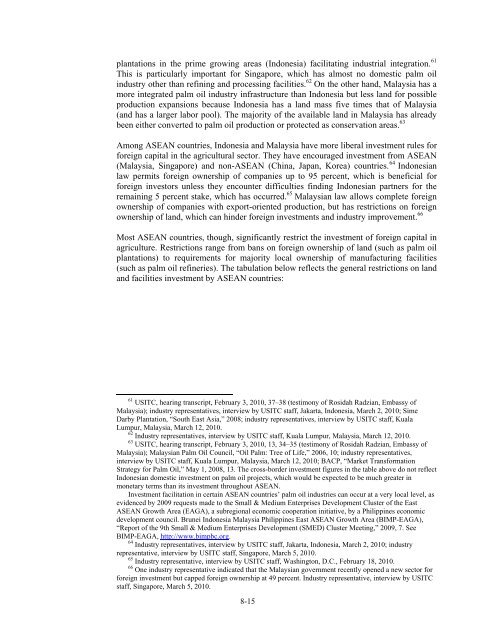ASEAN: Regional Trends in Economic Integration, Export ... - USITC
ASEAN: Regional Trends in Economic Integration, Export ... - USITC
ASEAN: Regional Trends in Economic Integration, Export ... - USITC
Create successful ePaper yourself
Turn your PDF publications into a flip-book with our unique Google optimized e-Paper software.
plantations <strong>in</strong> the prime grow<strong>in</strong>g areas (Indonesia) facilitat<strong>in</strong>g <strong>in</strong>dustrial <strong>in</strong>tegration. 61<br />
This is particularly important for S<strong>in</strong>gapore, which has almost no domestic palm oil<br />
<strong>in</strong>dustry other than ref<strong>in</strong><strong>in</strong>g and process<strong>in</strong>g facilities. 62 On the other hand, Malaysia has a<br />
more <strong>in</strong>tegrated palm oil <strong>in</strong>dustry <strong>in</strong>frastructure than Indonesia but less land for possible<br />
production expansions because Indonesia has a land mass five times that of Malaysia<br />
(and has a larger labor pool). The majority of the available land <strong>in</strong> Malaysia has already<br />
been either converted to palm oil production or protected as conservation areas. 63<br />
Among <strong>ASEAN</strong> countries, Indonesia and Malaysia have more liberal <strong>in</strong>vestment rules for<br />
foreign capital <strong>in</strong> the agricultural sector. They have encouraged <strong>in</strong>vestment from <strong>ASEAN</strong><br />
(Malaysia, S<strong>in</strong>gapore) and non-<strong>ASEAN</strong> (Ch<strong>in</strong>a, Japan, Korea) countries. 64 Indonesian<br />
law permits foreign ownership of companies up to 95 percent, which is beneficial for<br />
foreign <strong>in</strong>vestors unless they encounter difficulties f<strong>in</strong>d<strong>in</strong>g Indonesian partners for the<br />
rema<strong>in</strong><strong>in</strong>g 5 percent stake, which has occurred. 65 Malaysian law allows complete foreign<br />
ownership of companies with export-oriented production, but has restrictions on foreign<br />
ownership of land, which can h<strong>in</strong>der foreign <strong>in</strong>vestments and <strong>in</strong>dustry improvement. 66<br />
Most <strong>ASEAN</strong> countries, though, significantly restrict the <strong>in</strong>vestment of foreign capital <strong>in</strong><br />
agriculture. Restrictions range from bans on foreign ownership of land (such as palm oil<br />
plantations) to requirements for majority local ownership of manufactur<strong>in</strong>g facilities<br />
(such as palm oil ref<strong>in</strong>eries). The tabulation below reflects the general restrictions on land<br />
and facilities <strong>in</strong>vestment by <strong>ASEAN</strong> countries:<br />
61 <strong>USITC</strong>, hear<strong>in</strong>g transcript, February 3, 2010, 37–38 (testimony of Rosidah Radzian, Embassy of<br />
Malaysia); <strong>in</strong>dustry representatives, <strong>in</strong>terview by <strong>USITC</strong> staff, Jakarta, Indonesia, March 2, 2010; Sime<br />
Darby Plantation, “South East Asia,” 2008; <strong>in</strong>dustry representatives, <strong>in</strong>terview by <strong>USITC</strong> staff, Kuala<br />
Lumpur, Malaysia, March 12, 2010.<br />
62 Industry representatives, <strong>in</strong>terview by <strong>USITC</strong> staff, Kuala Lumpur, Malaysia, March 12, 2010.<br />
63 <strong>USITC</strong>, hear<strong>in</strong>g transcript, February 3, 2010, 13, 34–35 (testimony of Rosidah Radzian, Embassy of<br />
Malaysia); Malaysian Palm Oil Council, “Oil Palm: Tree of Life,” 2006, 10; <strong>in</strong>dustry representatives,<br />
<strong>in</strong>terview by <strong>USITC</strong> staff, Kuala Lumpur, Malaysia, March 12, 2010; BACP, “Market Transformation<br />
Strategy for Palm Oil,” May 1, 2008, 13. The cross-border <strong>in</strong>vestment figures <strong>in</strong> the table above do not reflect<br />
Indonesian domestic <strong>in</strong>vestment on palm oil projects, which would be expected to be much greater <strong>in</strong><br />
monetary terms than its <strong>in</strong>vestment throughout <strong>ASEAN</strong>.<br />
Investment facilitation <strong>in</strong> certa<strong>in</strong> <strong>ASEAN</strong> countries’ palm oil <strong>in</strong>dustries can occur at a very local level, as<br />
evidenced by 2009 requests made to the Small & Medium Enterprises Development Cluster of the East<br />
<strong>ASEAN</strong> Growth Area (EAGA), a subregional economic cooperation <strong>in</strong>itiative, by a Philipp<strong>in</strong>es economic<br />
development council. Brunei Indonesia Malaysia Philipp<strong>in</strong>es East <strong>ASEAN</strong> Growth Area (BIMP-EAGA),<br />
“Report of the 9th Small & Medium Enterprises Development (SMED) Cluster Meet<strong>in</strong>g,” 2009, 7. See<br />
BIMP-EAGA, http://www.bimpbc.org.<br />
64 Industry representatives, <strong>in</strong>terview by <strong>USITC</strong> staff, Jakarta, Indonesia, March 2, 2010; <strong>in</strong>dustry<br />
representative, <strong>in</strong>terview by <strong>USITC</strong> staff, S<strong>in</strong>gapore, March 5, 2010.<br />
65 Industry representative, <strong>in</strong>terview by <strong>USITC</strong> staff, Wash<strong>in</strong>gton, D.C., February 18, 2010.<br />
66 One <strong>in</strong>dustry representative <strong>in</strong>dicated that the Malaysian government recently opened a new sector for<br />
foreign <strong>in</strong>vestment but capped foreign ownership at 49 percent. Industry representative, <strong>in</strong>terview by <strong>USITC</strong><br />
staff, S<strong>in</strong>gapore, March 5, 2010.<br />
8-15

















